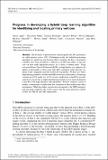Progress in developing a hybrid deep learning algorithm for identifying and locating primary vertices
Author(s)
Akar, Simon; Atluri, Gowtham; Boettcher, Thomas; Peters, Michael; Schreiner, Henry; Sokoloff, Michael; Stahl, Marian; Tepe, William; Weisser, Constantin; Williams, Mike; ... Show more Show less
DownloadPublished version (657.0Kb)
Publisher with Creative Commons License
Publisher with Creative Commons License
Creative Commons Attribution
Terms of use
Metadata
Show full item recordAbstract
<jats:p>The locations of proton-proton collision points in LHC experiments are called primary vertices (PVs). Preliminary results of a hybrid deep learning algorithm for identifying and locating these, targeting the Run 3 incarnation of LHCb, have been described at conferences in 2019 and 2020. In the past year we have made significant progress in a variety of related areas. Using two newer Kernel Density Estimators (KDEs) as input feature sets improves the fidelity of the models, as does using full LHCb simulation rather than the “toy Monte Carlo” originally (and still) used to develop models. We have also built a deep learning model to calculate the KDEs from track information. Connecting a tracks-to-KDE model to a KDE-to-hists model used to find PVs provides a proof-of-concept that a single deep learning model can use track information to find PVs with high efficiency and high fidelity. We have studied a variety of models systematically to understand how variations in their architectures affect performance. While the studies reported here are specific to the LHCb geometry and operating conditions, the results suggest that the same approach could be used by the ATLAS and CMS experiments.</jats:p>
Date issued
2021Department
Massachusetts Institute of Technology. Department of PhysicsJournal
EPJ Web of Conferences
Publisher
EDP Sciences
Citation
Akar, Simon, Atluri, Gowtham, Boettcher, Thomas, Peters, Michael, Schreiner, Henry et al. 2021. "Progress in developing a hybrid deep learning algorithm for identifying and locating primary vertices." EPJ Web of Conferences, 251.
Version: Final published version